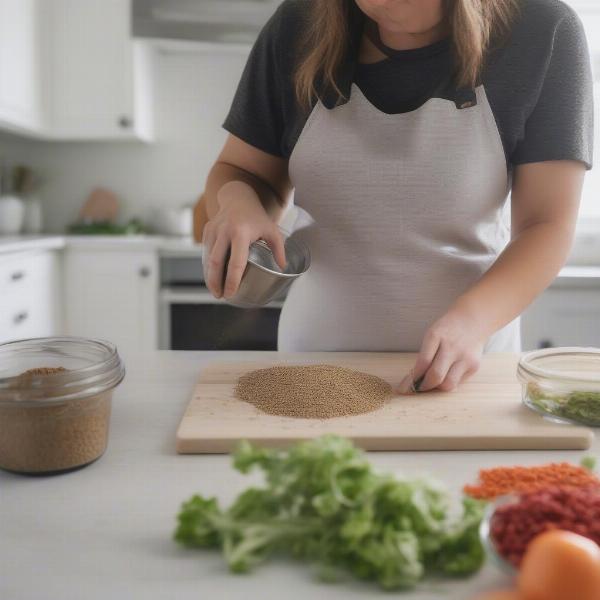Raw blend dog food, a mix of raw meat, bones, organs, and often vegetables and fruits, has gained popularity among dog owners seeking a more natural diet for their canine companions. This guide will explore the intricacies of raw blend dog food, covering its benefits, risks, preparation, and everything you need to know to make informed decisions about your dog’s nutrition.
Understanding Raw Blend Dog Food
Raw blend dog food aims to mimic a dog’s ancestral diet. Proponents believe it provides numerous health benefits, including shinier coats, healthier skin, improved dental health, and increased energy levels. However, it’s crucial to understand the potential risks associated with raw feeding, such as bacterial contamination and nutritional imbalances.
Benefits of Raw Blend Dog Food
Many dog owners report positive changes after switching to a raw blend diet. Some of the reported benefits include:
- Improved Digestion: Raw food can be easier for some dogs to digest than processed kibble.
- Increased Energy: A balanced raw diet can lead to higher energy levels.
- Healthier Skin and Coat: Essential fatty acids in raw food contribute to a glossy coat and healthy skin.
- Better Dental Health: Chewing on raw bones can help scrape away plaque and tartar buildup.
Risks of Raw Blend Dog Food
While raw blend diets can offer advantages, it’s essential to be aware of the potential risks:
- Bacterial Contamination: Raw meat can harbor harmful bacteria like Salmonella and E. coli, posing a risk to both dogs and humans.
- Nutritional Imbalances: Creating a balanced raw blend requires careful planning and knowledge of canine nutritional requirements. An improperly balanced diet can lead to deficiencies or excesses of certain nutrients.
- Bone Splintering: Feeding cooked bones is dangerous and should be avoided. While raw bones are generally safer, there’s still a risk of splintering, especially if the bones aren’t appropriate for your dog’s size and breed.
Preparing Raw Blend Dog Food
Preparing raw blend dog food at home requires meticulous attention to detail. You need to ensure the diet is nutritionally complete and balanced. This involves incorporating the correct ratios of meat, bones, organs, and other ingredients. Consult with a veterinary nutritionist to create a customized plan for your dog.  Preparing Raw Blend Dog Food
Preparing Raw Blend Dog Food
Is Raw Blend Right for Your Dog?
Deciding whether to transition your dog to a raw blend diet is a significant decision. Consider your dog’s age, breed, health status, and your lifestyle. If you’re concerned about the risks of raw feeding, discuss your options with your veterinarian. They can help you assess the potential benefits and drawbacks and guide you towards making the best choice for your dog.
Commercial Raw Blend Options
If you’re not comfortable preparing raw food yourself, several commercial raw blend options are available. These pre-made mixes can simplify the process and reduce the risk of nutritional imbalances. open farm dog food raw mix
Transitioning to Raw Blend Dog Food
If you decide to switch your dog to raw blend, do so gradually. Start by mixing a small amount of raw food with their current diet and slowly increase the proportion of raw food over several days or weeks. Monitor your dog for any digestive issues or changes in stool.
“A gradual transition is key to minimizing digestive upset when introducing raw blend dog food,” says Dr. Emily Carter, DVM. “Always monitor your dog closely for any signs of illness and consult with your veterinarian if you have any concerns.”
Maintaining Food Safety
Hygiene is paramount when handling raw meat. Wash your hands thoroughly after handling raw ingredients and disinfect all surfaces that come into contact with the food. Store raw meat separately from other foods in your refrigerator.
Conclusion
Raw blend dog food can be a viable dietary option for some dogs, but it’s not without risks. Thorough research, careful preparation, and ongoing monitoring are crucial. instinct rabbit dog food Always consult with your veterinarian before making any significant dietary changes for your furry friend. They can provide personalized advice and help you determine if raw blend is the right choice for your dog’s individual needs. dickvanpatten dog food
FAQ
- Is raw blend dog food safe? Raw food carries a risk of bacterial contamination and requires careful handling and preparation.
- What are the benefits of feeding raw blend? Potential benefits include improved digestion, healthier skin and coat, and increased energy.
- How do I transition my dog to a raw blend diet? Gradually introduce raw food over several days or weeks, monitoring your dog closely for any adverse reactions.
- Do I need to supplement a raw blend diet? Consult a veterinary nutritionist to ensure your dog’s nutritional needs are met.
- Where can I buy raw blend dog food? You can prepare it at home or purchase pre-made mixes from reputable suppliers. royal canin hypoallergenic wet dog food can dogs eat seafood sticks
- Are raw bones safe for dogs? Raw bones are generally safer than cooked bones, but there is still a risk of splintering. Choose appropriate bones for your dog’s size and breed.
- What if my dog gets sick after eating raw food? Contact your veterinarian immediately if your dog shows any signs of illness after consuming raw food.
ILM Dog is your trusted source for expert dog care advice. We offer comprehensive resources on breed selection, health, training, nutrition, and much more. Whether you’re a seasoned dog owner or just starting out, we’re here to help you provide the best possible care for your canine companion. Contact us for personalized advice at [email protected] or +44 20-3965-8624. ILM Dog is committed to providing the highest quality information and support to dog owners worldwide.